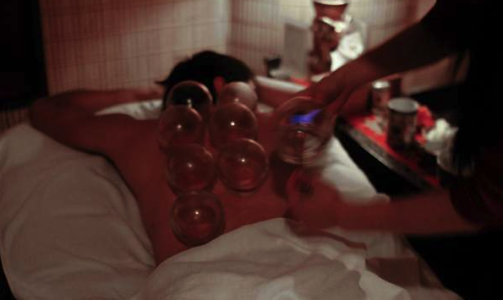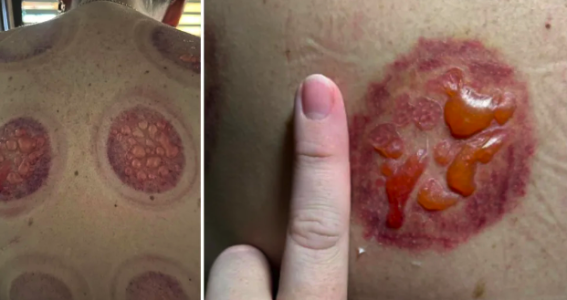Popular healing therapy leaves a woman with 'painful' burns
- Replies 8
Content warning: This article may contain graphic images of burns and injuries. Viewer discretion is advised. If you are sensitive to such content, we recommend proceeding with caution.
It's essential that we prioritise self-care and maintain the health of our bodies, especially for those dealing with medical conditions who must be attentive to their physical well-being.
When we face pain or discomfort, there are numerous natural remedies and alternative techniques available to aid in the healing process.
One such alternative therapy that has gained popularity in recent times is fire cupping.
Fire cupping, originating from traditional Chinese medicine, typically involves practitioners heating a glass or bamboo cup with a flaming alcohol-soaked cotton ball before applying it to the patient's body.
This practice is said to improve blood flow, eliminate toxins, and alleviate pain.

However, as one Queensland woman recently found out, fire cupping is not as harmless as you would think.
Larita De Ruysscher told a local news outlet that after suffering from a 'very sore neck and shoulders', she decided to try a fire cupping therapy session at a business in her local shopping centre.
But when she returned home after the treatment, she discovered second-degree burns all across her back.
'It started to get really uncomfortable during [the fire cupping],' Larita said.
'It was a relief when [the practitioner] took them off. I didn't realise anything until he started rubbing my back and talking about the jelly.'
Seeking medical advice, Larita returned to the business to show them the aftermath of her session. Unfortunately, the response she received was far from sympathetic. She recounted, 'I was told it's normal in China, and I'll be okay.'
They also explained blistering can occur depending on a patient's skin type and offered the woman a free treatment and massage.
However, it wasn't until Larita posted alarming images of her injuries on social media that people began to understand the seriousness of her situation.
In her post, she warned, 'I wouldn't recommend it to anyone, and I would hate for anyone else to have my experience.'

It was later confirmed that while bruises can be expected with fire cupping, burns are not considered 'normal'.
Dr Richard Kidd, a General Practitioner, explained that burns are a known risk associated with fire cupping, albeit to some extent.
Acupuncture and Chinese Medicine Association President Waveny Holland also added, ‘You don’t burn patients. It’s therapeutically not beneficial, plus it breaks the skin (and) it’s open to infection.’
Despite their insistence that they did nothing wrong, the business eventually apologised to Larita for her ordeal.
She is now contemplating filing a complaint with the Office of the Health Ombudsman, emphasising the pain and discomfort she endured, stating, 'It's really not very good, and it's really painful.'
The Aged Care Quality and Safety Commission reports that older individuals are more likely to sustain burn injuries.
This increased vulnerability stems from several factors, including thinner and more delicate skin, decreased ability to sense heat, and potentially limited mobility to swiftly distance themselves from a heat source.

Members, if you've been experiencing pain, we strongly recommend discussing it with your doctor first before trying any alternative therapies.
What are your thoughts on this news? Have any of you ever tried fire cupping? If so, how was the experience? Feel free to share your thoughts in the comments section below!
It's essential that we prioritise self-care and maintain the health of our bodies, especially for those dealing with medical conditions who must be attentive to their physical well-being.
When we face pain or discomfort, there are numerous natural remedies and alternative techniques available to aid in the healing process.
One such alternative therapy that has gained popularity in recent times is fire cupping.
Fire cupping, originating from traditional Chinese medicine, typically involves practitioners heating a glass or bamboo cup with a flaming alcohol-soaked cotton ball before applying it to the patient's body.
This practice is said to improve blood flow, eliminate toxins, and alleviate pain.

Fire cupping involves suction of the skin, often with glass cups, in sore zones on the body. Credit: Flickr.
However, as one Queensland woman recently found out, fire cupping is not as harmless as you would think.
Larita De Ruysscher told a local news outlet that after suffering from a 'very sore neck and shoulders', she decided to try a fire cupping therapy session at a business in her local shopping centre.
But when she returned home after the treatment, she discovered second-degree burns all across her back.
'It started to get really uncomfortable during [the fire cupping],' Larita said.
'It was a relief when [the practitioner] took them off. I didn't realise anything until he started rubbing my back and talking about the jelly.'
Seeking medical advice, Larita returned to the business to show them the aftermath of her session. Unfortunately, the response she received was far from sympathetic. She recounted, 'I was told it's normal in China, and I'll be okay.'
They also explained blistering can occur depending on a patient's skin type and offered the woman a free treatment and massage.
However, it wasn't until Larita posted alarming images of her injuries on social media that people began to understand the seriousness of her situation.
In her post, she warned, 'I wouldn't recommend it to anyone, and I would hate for anyone else to have my experience.'

The woman was left with serious burns when she tried fire cupping to resolve issues with her neck and shoulder. Credit: Facebook.
It was later confirmed that while bruises can be expected with fire cupping, burns are not considered 'normal'.
Dr Richard Kidd, a General Practitioner, explained that burns are a known risk associated with fire cupping, albeit to some extent.
Acupuncture and Chinese Medicine Association President Waveny Holland also added, ‘You don’t burn patients. It’s therapeutically not beneficial, plus it breaks the skin (and) it’s open to infection.’
Despite their insistence that they did nothing wrong, the business eventually apologised to Larita for her ordeal.
She is now contemplating filing a complaint with the Office of the Health Ombudsman, emphasising the pain and discomfort she endured, stating, 'It's really not very good, and it's really painful.'
The Aged Care Quality and Safety Commission reports that older individuals are more likely to sustain burn injuries.
This increased vulnerability stems from several factors, including thinner and more delicate skin, decreased ability to sense heat, and potentially limited mobility to swiftly distance themselves from a heat source.
Key Takeaways
- A woman in Queensland suffered second-degree burns after receiving fire cupping therapy.
- Larita De Ruysscher went for the treatment due to a 'very sore neck and shoulders' but was left with painful and blistering burns.
- She shared her experience online, asking others if they had similar experiences, with many claiming bruises were common but burns were not.
- The business owner defended that blistering can occur depending on a patient's skin type but offered the woman a free treatment and massage.
Members, if you've been experiencing pain, we strongly recommend discussing it with your doctor first before trying any alternative therapies.
What are your thoughts on this news? Have any of you ever tried fire cupping? If so, how was the experience? Feel free to share your thoughts in the comments section below!







